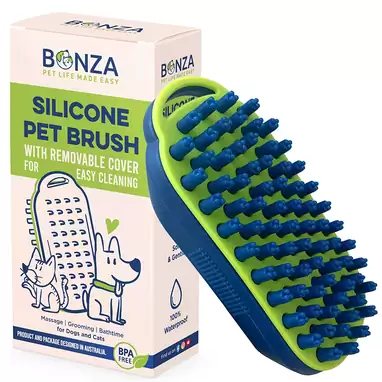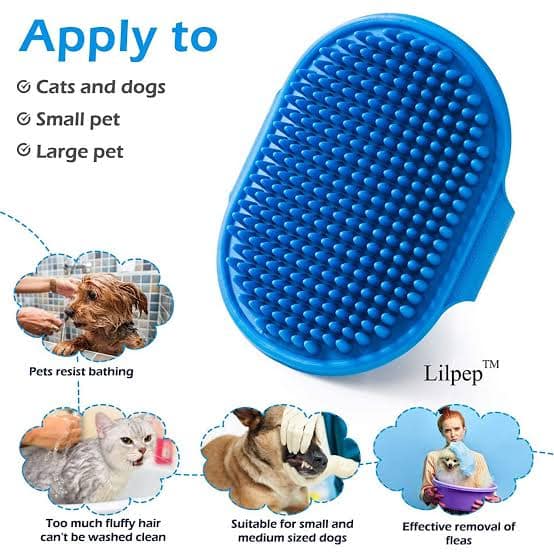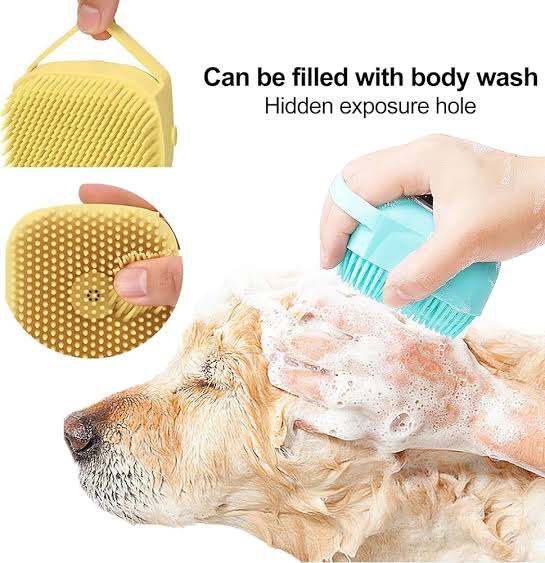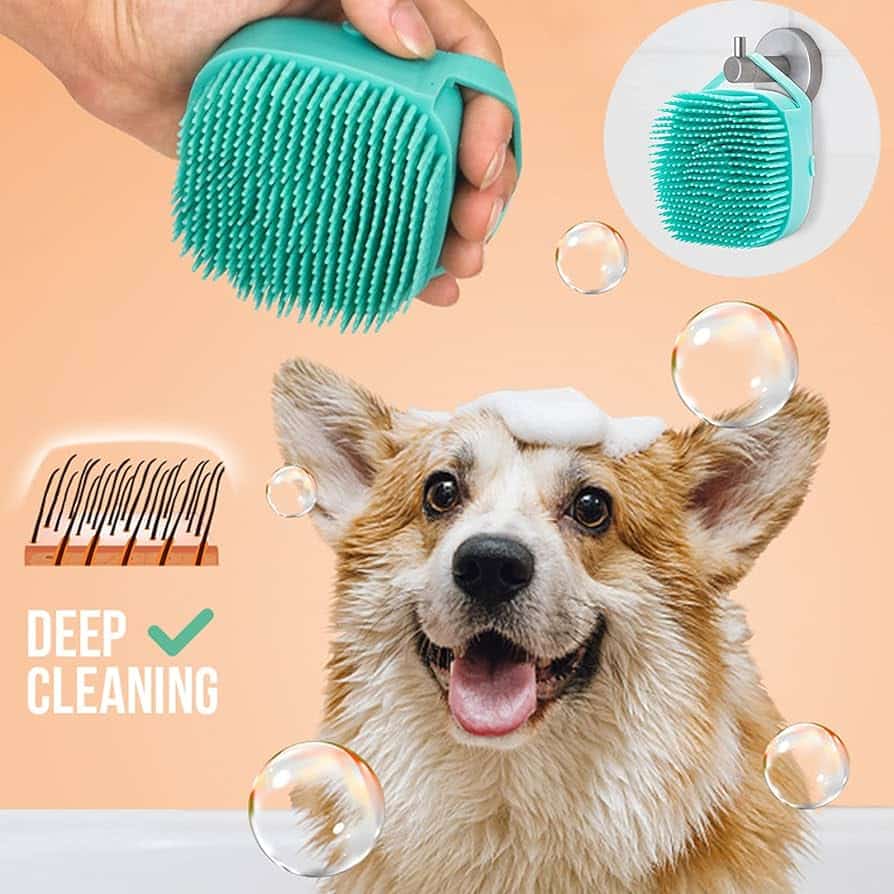If you are a dog lover and would like to keep it clean, then you need this article on “How To Use A Dog Bath Brush”. Other subtopics we shall discuss are: Understanding Your Dog’s Coat, Types Of Dog Bath Brushes, Preparing Your Dog For Brushing, Step-by-Step Guide On How To Use A Dog Bath Brush, etc.
Bathing your dog is not just a task; it’s an opportunity to strengthen the bond between you and your canine companion while ensuring their well-being. In this guide, we delve into the essential skill of using a dog bath brush. It is a simple yet powerful tool that can transform bath time into a therapeutic and beneficial experience for both you and your pup.
As we explore how to use a dog bath brush effectively, you’ll discover the art of maintaining your dog’s coat, promoting skin health, and turning grooming sessions into moments of joy. Whether you’re a seasoned pet owner or a first-time pup parent, this guide aims to demystify the process, making it an enjoyable and rewarding part of your canine care routine. Let’s embark on this journey to enhance your dog’s grooming routine and make bath time a tail-wagging success.
Understanding Your Dog’s Coat
When it comes to grooming your furry friend, understanding your dog’s coat is the first step in ensuring their well-being. Dogs boast a variety of coat types, each with unique grooming requirements that can be addressed effectively with the right tools, such as a dog bath brush.

Different Coat Types And Grooming Requirements
- Short Coats: Breeds like Dachshunds or Beagles often have short, dense coats. Regular brushing with a dog bath brush helps remove loose fur and keeps the coat shiny.
- Long Coats: Breeds like Shih Tzus or Collies flaunt luxurious long coats. These require careful detangling and preventing matting, which a dog bath brush adeptly accomplishes.
How A Dog Bath Brush Caters To Specific Coat Needs
- Slicker Brushes: Ideal for removing loose fur and preventing matting in long-haired breeds.
- Bristle Brushes: Effective in distributing natural oils, promoting shine in short coats.
- Rubber Brushes: Gentle massaging and effective in short-haired breeds, aiding in cleaning and stimulating the skin.
The Link Between Regular Brushing And Overall Skin And Coat Health
Regular brushing with a dog bath brush is not just about maintaining a neat appearance. It plays a crucial role in your dog’s skin and coat health. By removing loose fur, distributing oils evenly, and preventing matting, you contribute to:
- Reduced shedding and hairballs
- Improved blood circulation
- Prevention of skin irritations and infections
Regular brushing becomes a proactive measure in promoting optimal skin and coat health, making your dog’s grooming experience a positive and beneficial one.
Types Of Dog Bath Brushes
When it comes to grooming your canine companion, having the right tools, including a dog bath brush, is key to maintaining a healthy and happy coat. Let’s explore the various types of dog bath brushes, their specific purposes, and how to choose the perfect one for your furry friend.
Overview Of Various Brush Types and Their Purposes
- Slicker Brushes: Equipped with fine, short wires close together, these brushes excel in removing loose fur, preventing matting, and untangling knots. Ideal for long-haired breeds.
- Bristle Brushes: With natural bristles, these brushes are effective in distributing natural oils, promoting shine, and removing loose hair, making them suitable for short-haired breeds.
- Rubber Brushes: Known for their flexibility, rubber brushes are great for massaging, gentle cleaning, and removing loose fur in short-haired breeds.
Factors To Consider When Selecting A Brush For Your Dog
- Coat Type: Consider your dog’s coat length and texture. Different brushes cater to various coat types, ensuring effective grooming without causing discomfort.
- Sensitivity: Some dogs may have more sensitive skin. Choosing a brush with softer bristles or rubber tips can be gentler on their skin while still being effective.
Ensuring The Brush Is Suitable For Your Dog’s Breed And Coat Characteristics
- Long-Haired Breeds: Opt for slicker brushes to manage tangles and prevent matting.
- Short-Haired Breeds: Bristle brushes or rubber brushes work well for promoting shine and massaging the skin.
Choosing a dog bath brush tailored to your dog’s needs ensures an enjoyable grooming experience. Regular brushing not only keeps their coat healthy but also strengthens the bond between you and your pup. So, pick the right brush, and let the grooming sessions be moments of joy and care for both you and your furry friend.

Preparing Your Dog For Brushing
Here are the key steps to prepare your dog for brushing, with a focus on creating a comfortable environment, introducing the dog bath brush gradually, and managing any anxiety during grooming sessions.
Creating A Positive Environment
To set the stage for successful brushing sessions, create a positive environment. Choose a quiet, well-lit area with minimal distractions. Lay out a non-slip mat to provide stability for your dog and make the grooming space feel secure. Using treats or toys can also help associate the grooming area with positive experiences.
Introducing Your Dog To The Bath Brush Gradually
Make the introduction to the dog bath brush a gradual and gentle process. Start by allowing your dog to sniff and explore the brush without using it. Use positive reinforcement, such as treats or praise, to associate the brush with positive feelings. Gradually progress to short, gentle brush strokes, ensuring your dog remains comfortable and relaxed.
Tips For Managing Anxiety Or Resistance
If your dog displays anxiety or resistance during brushing, take it slow and be patient. Break the brushing process into shorter sessions, gradually increasing the duration as your dog becomes more accustomed. Use soothing words and gentle touches to reassure your pet. Additionally, rewarding your dog with treats or a favorite activity after each successful brushing session can reinforce positive behavior.

Step-by-Step Guide On How To Use A Dog Bath Brush
Properly using a dog bath brush is key to keeping your furry friend’s coat healthy and shiny. Follow this simple step-by-step guide to make the brushing process smooth and enjoyable for both you and your pet.
1. Preparation
Before you start, gather your dog bath brush, treats, and ensure a quiet, comfortable space. Brushing works best on a dry coat, so make sure your dog is dry and relaxed.
2. Introduction To The Brush
Begin by letting your dog sniff and inspect the brush. Offer positive reinforcement like treats and gentle praise to create a positive association with the brush. This helps your dog feel at ease.
3. Brushing Different Areas
Head And Neck:
- Gently brush the head and neck in the direction of hair growth. Be extra gentle around sensitive areas like the ears and muzzle.
- Use short, light strokes to remove any loose hair or tangles.
Chest And Back:
- Continue with smooth strokes along the chest and back, paying attention to the direction of hair growth.
- If your dog has a longer coat, use a slicker brush to prevent matting.
Belly and Legs:
- Lift your dog’s legs one at a time to reach the belly. Use gentle strokes to remove loose fur.
- Be cautious around sensitive areas, and reward your dog for good behavior.
Tail:
- Brush the tail using long, gentle strokes. Take care around the base of the tail where the fur may be thicker.
4. Tailored Brushing Techniques
- For short-haired dogs, a curry brush works well for removing loose hair and promoting a healthy coat.
- Long-haired breeds may benefit from a combination of slicker and pin brushes to prevent matting.
5. Final Touches
- Once you’ve brushed each area, give your dog extra love and praise. This reinforces positive behavior during the grooming process.
- Check for any signs of irritation or discomfort and address them promptly.
Maintaining The Dog Bath Brush
Caring for your dog bath brush is essential to ensure effective grooming and a happy, healthy pup. Follow these simple steps to maintain your dog bath brush and keep it in top-notch condition.
1. Regular Cleaning: Regularly clean your dog bath brush to remove accumulated hair, dirt, and oils. Use a comb or your fingers to gently pull out trapped fur. For a deeper clean, soak the brush in mild soapy water, ensuring it’s completely dry before the next use.
2. Check for Wear and Tear: Inspect the bristles and overall condition of the brush regularly. If you notice any damaged bristles or signs of wear, it might be time to replace the brush. A well-maintained brush ensures a comfortable grooming experience for your dog.
3. Tailor Cleaning to Brush Type: Different dog bath brushes require varying cleaning methods. Slicker brushes may need more frequent cleaning due to their design, while pin brushes may require occasional detangling. Understanding your brush type helps in tailoring your maintenance routine.
4. Storage Matters: Store your dog bath brush in a dry and clean place to prevent the growth of mold or bacteria. Proper storage not only extends the life of the brush but also ensures a hygienic grooming experience for your pet.
5. Replace When Necessary: If your dog bath brush is showing signs of wear, such as bent or missing bristles, consider replacing it. A worn-out brush can be less effective and might cause discomfort to your dog during grooming.
6. Consider Specialized Cleaning Products: Some brushes may benefit from specialized cleaning products. Research the specific needs of your dog bath brush type and invest in suitable cleaning solutions to maintain its functionality.
7. Regular Inspection During Grooming: Incorporate a quick inspection of the brush during grooming sessions. This allows you to spot any issues promptly, ensuring a seamless and enjoyable grooming experience for your furry friend.

Common Mistakes In Using A Dog Bath Brush
Using a dog bath brush is a wonderful way to keep your furry friend’s coat in top shape, but it’s essential to be mindful of common errors that may occur during grooming. Here are some potential issues and simple tips to rectify them, emphasizing the importance of gentle and patient grooming practices.
1. Brushing Too Aggressively
Issue: Brushing too vigorously can cause discomfort and even harm your dog’s skin.
Correction: Opt for gentle, controlled strokes. Start with light pressure and gradually increase as needed. If you encounter resistance, take it slow and use soothing words to reassure your pet.
2. Neglecting Sensitive Areas
Issue: Overlooking sensitive areas, like the ears and paws, can lead to discomfort and resistance.
Correction: Pay special attention to sensitive spots. Use a gentle touch, and if your dog shows signs of discomfort, pause and resume after a moment. Reward good behavior with treats.
3. Using The Wrong Brush Type
Issue: Not all dog bath brushes are suitable for every coat type. Using the wrong brush may be ineffective or cause discomfort.
Correction: Choose the right brush for your dog’s coat. Short-haired breeds benefit from curry brushes, while longer-haired ones may require slicker or pin brushes. Research your dog’s breed to find the ideal tool.
4. Inconsistent Grooming Routine
Issue: Inconsistency in grooming sessions can lead to matting, tangles, and increased shedding.
Correction: Establish a regular grooming routine. Consistent brushing helps maintain a healthy coat and reduces the likelihood of discomfort during grooming sessions.
5. Ignoring Signs Of Discomfort
Issue: Ignoring your dog’s cues of discomfort can lead to anxiety and resistance during grooming.
Correction: Pay attention to your dog’s body language. If they seem uneasy or show signs of distress, pause and reassure them. Gradually reintroduce the brush, ensuring a positive association.
6. Rushing Through The Process
Issue: Rushing through brushing can result in missed spots, uneven grooming, and a less enjoyable experience for your pet.
Correction: Take your time during grooming sessions. Break the process into smaller steps, and don’t hesitate to pause and reward your dog for good behavior. A patient approach ensures a positive grooming experience.
FAQs
How Often Should I Use A Dog Bath Brush On My Pet?
The frequency of using a dog bath brush depends on your dog’s breed and coat type. Generally, brushing once or twice a week is recommended for most breeds. However, longer-haired breeds might benefit from more frequent brushing to prevent matting.
Can I Use Any Brush For My Dog ?
It’s essential to choose the right brush for your dog’s coat. Short-haired dogs may require a curry brush, while longer-haired breeds may benefit from slicker or pin brushes. Research your dog’s breed to determine the most suitable brush.
What should I Do If My Dog Doesn’t Like Being Brushed?
If your dog is resistant to brushing, start slow and use positive reinforcement. Introduce the brush gradually, offer treats, and praise good behavior. Break the grooming process into shorter sessions, allowing your dog to become accustomed to the experience over time.
Are There Specific Techniques For Brushing Different Areas Of My Dog’s Coat?
Yes, different areas may require specific brushing techniques. Use gentle, short strokes on the head and neck, longer strokes on the body, and be cautious around sensitive areas like ears and paws. Tailor your brushing techniques based on your dog’s comfort.
How Should I Clean And Maintain My Dog Bath Brush?
Regularly remove trapped hair from the brush using a comb or your fingers. For a deeper clean, soak the brush in mild soapy water, ensuring it’s completely dry before use. Inspect the brush for wear and tear, and replace it if needed.
Can I Use A Human Brush On My Dog?
It’s not recommended to use a human brush on your dog, as their coat and skin have different needs. Invest in a dog bath brush designed for your pet’s specific coat type to ensure effective and comfortable grooming.
My Dog Has Sensitive Skin. Can I Still Use A Bath Brush?
Yes, you can still use a bath brush on a dog with sensitive skin. Choose a brush with softer bristles, and be extra gentle during the grooming process. If you notice any signs of irritation, consult with your veterinarian for guidance.
Conclusion
Incorporating a dog bath brush into your grooming routine is a simple yet effective way to ensure your furry friend’s coat stays healthy and shiny. By following the step-by-step guide, you provide your pet with a positive and comfortable grooming experience.
Remember, the key is to be patient and gentle, considering your dog’s comfort at every step. Choosing the right brush for your dog’s coat type and maintaining it regularly keeps the grooming process smooth and enjoyable.
Whether you’re a seasoned pet owner or a new one, embracing these practices not only contributes to a healthier coat but also strengthens the bond between you and your canine companion.
So, grab your dog bath brush, create a calm environment, and make grooming a joyful activity for both you and your beloved pet. Your dog’s well-being and the shine of their coat will surely reflect the care and love you invest in their grooming routine.
